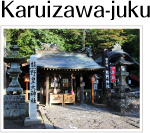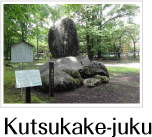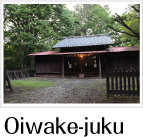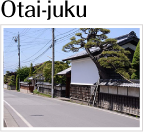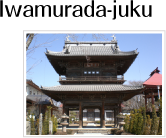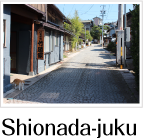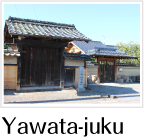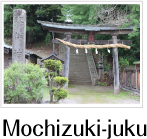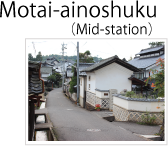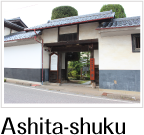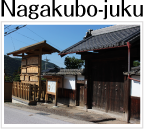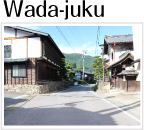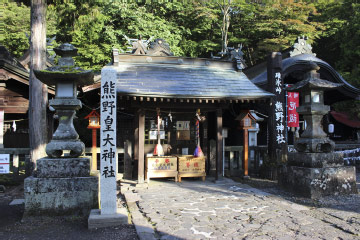
Karuizawa-juku is the 18th Post town from Edo and is one way to enter Nagano. The distance to the peak of Usui Pass from Sakamoto-juku, which is the Post town to Usui Pass, is around 13 km; this was a difficult part of the route that had rugged and steep mountain trails. You can see the view of mountains of the Kanto region from the top of the pass as travelers of those days may have seen them. Karuizawa-juku is currently called Kyu-Karuizawa Ginza and is still attracting many tourists,although the atmosphere of the Edo has period foded.
- Karuizawa-juku
- Kutsukake-juku
- Oiwake-juku
- Otai-juku
- Iwamurada-juku
- Shionada-juku
- Yawata-juku
- Mochizuki-juku
- Motai-ainoshuku
- Ashita-shuku
- Nagakubo-juku
- Wada-juku
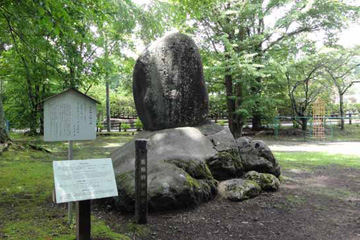
The Osasa Kaido that leads to Kusatsu or Suzaka from here. A massive fire burned down most of the town, it was later renamed Naka-karuizawa. In Nagakura Park stands a monument to the novel `Kutsukake Tokijiro` by shin Hasegawa. On it is inscribed a line from its leading character that reads, (I never bend my mind for money. But if you are talking about the milk of human kindness, it is a different story. I am a man named Kutsukake Tokijiro who is standing under three lines of smoke from Mt. Asama.) From a spot along the Yugawa River on the east side of Kutsukake-juku, you can see Mt. Asama on the left. Because of this, this spot became very popular among travelers since Mt. Asama is always seen on the right side on the way from Edo.
- Karuizawa-juku
- Kutsukake-juku
- Oiwake-juku
- Otai-juku
- Iwamurada-juku
- Shionada-juku
- Yawata-juku
- Mochizuki-juku
- Motai-ainoshuku
- Ashita-shuku
- Nagakubo-juku
- Wada-juku
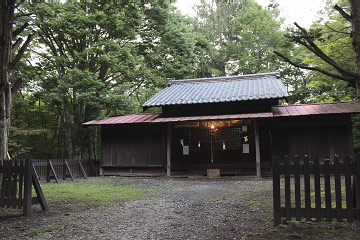
In the Edo period, Karuizawa-juku, Kutsukake-juku and Oiwake-juku at the southern foot of Mt.Asama were called the three post towns of Asama Negoshi Especially, Oiwake-juku, located at a junction of the Nakasendo and the Hokkoku Kaido, was lively with daimyos who took turns in attending the Edo Shogunate and travelers who visited Zenko-ji Temple. People who wear the travel outfits of those days liven up Shinano Oiwake Magouta Dochu, which is a festival currently held. The Oiwake-juku Local Museum, which is located at the Oiwake-juku gate to Edo, exhibits commodities used at the Post town in the old days and reproduces part of a tea-house.
- Karuizawa-juku
- Kutsukake-juku
- Oiwake-juku
- Otai-juku
- Iwamurada-juku
- Shionada-juku
- Yawata-juku
- Mochizuki-juku
- Motai-ainoshuku
- Ashita-shuku
- Nagakubo-juku
- Wada-juku
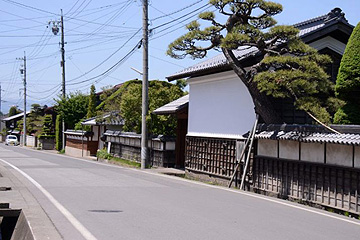
It was quite post town next to the vibrant neighborhoods of Iwamurada-juku and Oiwake-juku. As woman preferred this quite post town, it was sometimes called Hime-no-juku(post town of Princesses). Otai-juku is the 21st Post town from Edo Itabashi-juku and 40 ri and 14 cho (approximately 160 km) away from Edo and 95 ri and 8 cho (approximately 370 km) away from Kyo (Kyoto). Otai-juku is said to have had only five hatago and was a quiet Post town between Oiwake-juku on the Edo side and Iwamurada-juku on the Kyoto side. The daimyos attending the Edo Shogunate were thought to have been put up at inns in the next, Oiwake-juku due to its size and Otai-juku was called an Inn for Princesses since many women including princesses rested and stayed there.
- Karuizawa-juku
- Kutsukake-juku
- Oiwake-juku
- Otai-juku
- Iwamurada-juku
- Shionada-juku
- Yawata-juku
- Mochizuki-juku
- Motai-ainoshuku
- Ashita-shuku
- Nagakubo-juku
- Wada-juku
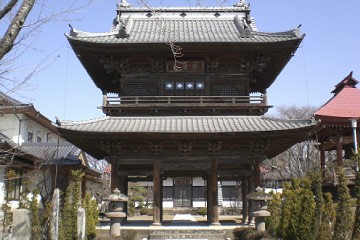
In the Muromachi period, the Oi clan had a vast estate in the eastern area of Shinano (current Nagano Prefecture) and the western area of Joshu (current Gunma Prefecture). The Iwamurada area where the Oi clan lived had six thousand houses and was the city with the most trade in Shinano. However, Iwamurada fell into ruins due to the flames of war brought by the Murakami army. In the Age of Warring States, the Iwamurada area revived as a strategically important point under the rule of the Takeda clan. The full-scale restoration of Iwamurada was completed in the Edo period; it was selected as a Post town of the Nakasendo and was developed as the new Iwamurada-juku. In 1703, the Naito clan was approved as the lord of the Iwamurada domain. However, the castle town was not finally built there until 1864. The castle town was built along with Fujigajo Castle in Uenojou where Iwamurada Elementary School stands today.
- Karuizawa-juku
- Kutsukake-juku
- Oiwake-juku
- Otai-juku
- Iwamurada-juku
- Shionada-juku
- Yawata-juku
- Mochizuki-juku
- Motai-ainoshuku
- Ashita-shuku
- Nagakubo-juku
- Wada-juku
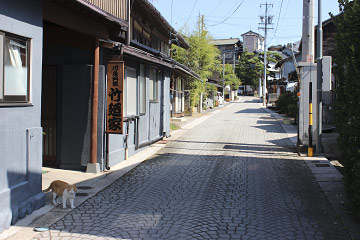
Shionada-juku was a riverside post town built on the east bank of the Chikuma River. The flooding of the Chikuma River, referred to as an unprecedented stormy river in neighboring districts, was important for the post town since it stopped travelers. Old trade name signboards still hang around the townscape with some remaining lattice doors. The large stone with a hole called Funetsunagiishi used to moor boats still watches travelers crossing the bridge over the river.
- Karuizawa-juku
- Kutsukake-juku
- Oiwake-juku
- Otai-juku
- Iwamurada-juku
- Shionada-juku
- Yawata-juku
- Mochizuki-juku
- Motai-ainoshuku
- Ashita-shuku
- Nagakubo-juku
- Wada-juku
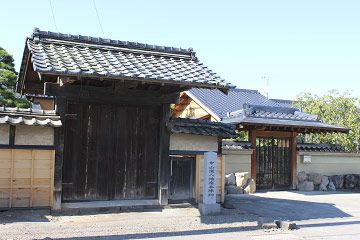
Yawata-juku was built by people who moved from the Yawata, Yomogida and Kuwayama areas. After crossing the Chikuma River, Yawata-juku is only 27 cho (approximately 3 km) ahead. Since the Chikuma River flows between Shionada and Yawata -juku, the distance between these post towns is very short. Also, the east side of Yawata-juku was the lower field of Gorobei Shinden Village that was later developed by Ichikawa Gorobei; the strong clay soil there was suitable for rice paddies. Princess Kazu and her party walked down the Nakasendo and stayed at Wada-juku on November 6, 1861; on the next day, November 7, they took their lunch break at Ashita-shuku and then stayed at Yawata-juku. Origami bestowed by Princess Kazu also was handed down in the Komatsu family who acted as the honjin/ton-ya for generations.
- Karuizawa-juku
- Kutsukake-juku
- Oiwake-juku
- Otai-juku
- Iwamurada-juku
- Shionada-juku
- Yawata-juku
- Mochizuki-juku
- Motai-ainoshuku
- Ashita-shuku
- Nagakubo-juku
- Wada-juku
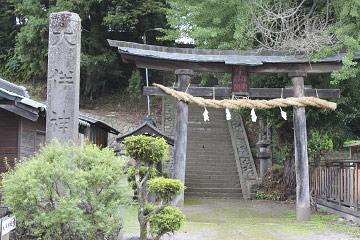
The Mochizuki area was well-known for raising excellent horses. The area was under direct control of the Imperial Court. For hundreds of years, these horses were donated to emperors and nobles. This explains why the phrase "Mochizuki’s horses" often appears in Japanese "waka" poems. Mochizuki has been called Koma no Sato (village of horses) since the Heian period; horses of the Imperial Court were pastured here and many great horses were presented. This place appeared in poems by many poets including Kino Tsurayuki and has attracted people through the ages. The Mochizuki Folk Heritage Museum located at the site of the former Honjin has an elegant structure including beams from demolished houses.
- Karuizawa-juku
- Kutsukake-juku
- Oiwake-juku
- Otai-juku
- Iwamurada-juku
- Shionada-juku
- Yawata-juku
- Mochizuki-juku
- Motai-ainoshuku
- Ashita-shuku
- Nagakubo-juku
- Wada-juku
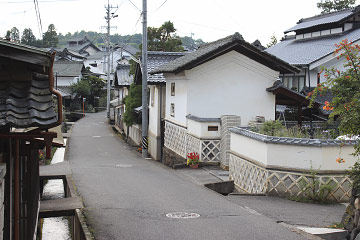
Motai-ainoshuku was located between Ashita-shuku and Mochizuku-juku. The term "Ainoshuku" refers to a rest station that lies between post towns. Motai-ainoshuku did not have lodging facilities because the shogunate issued a ban and controlled accommodations in all areas other than the post towns in order to protect them. The irrigation canals can still be seen in the old town. Ichirozaemon, who was the headman of the village, started brewing sake here in 1689. Currently, the two sake breweries are Osawa Sake Brewery and Takeshige Honke Brewing. The Wakayama Bokusui poem monument is on the site of the vault (kura) facing the street of Takeshige Honke Brewing Corp. Even now, the Motai ainoshuku has an old town atmosphere that is attracting travelers.
- Karuizawa-juku
- Kutsukake-juku
- Oiwake-juku
- Otai-juku
- Iwamurada-juku
- Shionada-juku
- Yawata-juku
- Mochizuki-juku
- Motai-ainoshuku
- Ashita-shuku
- Nagakubo-juku
- Wada-juku
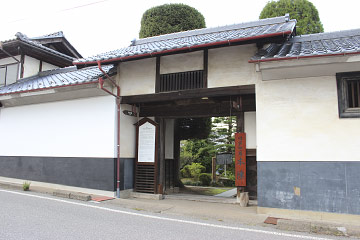
The written petition (Gamon) was dedicated to Tateshina Shrine in 1597 by Iwama Chusuke, Tsuchiya Emonnojo, and Imai Sogoro. Iwana and Tsuchiya ware ronin of the Ashita(Yoda) clan and Imai was a local Shinto priest. Together, they established the Ashita-shuku that became the 26th post town of the Nakasendo. Based on the petition, Ashita-shuku is the oldest post town in the northern Saku region. It was used as a resting area for court nobles and powerful feudal rulers. As time changed, aging buildings were difficult to preserve; some of them were lost to fire. However, the honjin (main shine area) built in the 1800s is still present today. The history of this area creates a feeding of nostalgia of the olden days. In the Edo period, pine and cedar trees were planted alongside the roads as a result of the tree planting policy of the Tokugawa Shogunate. The-150-300 year-old trees take us back in time to imagine and appreciate the feelings of those who walked along the same trees during the Nakasendo of that time.
- Karuizawa-juku
- Kutsukake-juku
- Oiwake-juku
- Otai-juku
- Iwamurada-juku
- Shionada-juku
- Yawata-juku
- Mochizuki-juku
- Motai-ainoshuku
- Ashita-shuku
- Nagakubo-juku
- Wada-juku
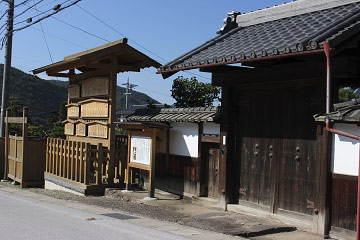
Nagakubo-juku was originally established in an area along the Yoda River, west of its current location. It was washed away by a disastrous flood and transferred to this fluvial terrace. Then Tate-machi Town was formed east to west, centering around the honjin and ton-ya. Yoko-machi Town was formed from north to south as the post town flourished, and Nagakubo-juku eventually turned into an L-shaped Post town. Nagakubo-juku had at most 43 hatago, and has the second most hatago next to Shiojiri-juku among the 26 Nakasendo Shinano post towns.
- Karuizawa-juku
- Kutsukake-juku
- Oiwake-juku
- Otai-juku
- Iwamurada-juku
- Shionada-juku
- Yawata-juku
- Mochizuki-juku
- Motai-ainoshuku
- Ashita-shuku
- Nagakubo-juku
- Wada-juku
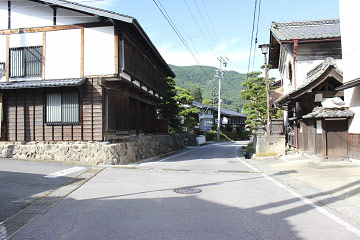
Wada-juku sits below Wada Pass, the highest and most difficult stage of the Nakasendo at 1600m above sea level; it is around 22 km from the next post town, Shimosuwa-juku. The difference in altitude with Wada Pass was around 800m. Many daimyo processions and travelers stayed here and this post town was one of the largest post towns among the 26 Shinano post towns along with Nagakubo-juku. In March 1861 during the end of the Edo period, the honjin and most of the post town were lost by fire. However, since Princess Kazu’s procession form Kyoto to Edo was scheduled for November of that year, this post town received 2000 ryo from the shogunate, rebuilt the town and safely welcomed the princess and her large escort.


